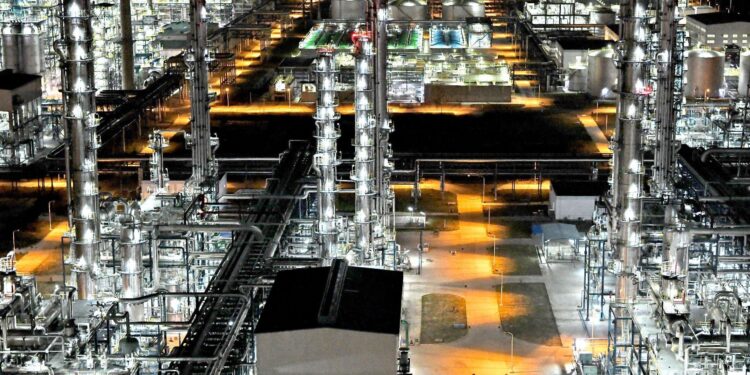In an increasingly complex global economic landscape, the trade tensions between the United States and China have intensified, leading to a multifaceted conflict that extends beyond traditional tariffs and trade barriers. Amid this tumultuous backdrop, China has begun to leverage an unprecedented asset in its ongoing tariff war: a rapidly growing army of advanced robotics and automation technologies. This strategic pivot is not only reshaping the dynamics of manufacturing and logistics within the country but also presenting new challenges for its competitors. As Beijing invests heavily in robotics, the implications for global trade and the future of economic competition become ever more pronounced. This article examines how China’s embrace of automation is altering the battlefield of international trade, potentially giving it an edge in a conflict marked by uncertainty and shifting power dynamics.
China’s Robotic Arsenal: A Strategic Advantage in the Tariff Conflict
As the ongoing tariff conflict strains economic relations between the United States and China, the latter’s growing reliance on automation and robotics presents a valuable strategic advantage. The implementation of advanced robotic technologies across various sectors has allowed Chinese manufacturers to enhance productivity and reduce costs significantly. This shift towards automation not only mitigates the vulnerabilities traditionally associated with human labor, such as strikes or health crises but also reinforces China’s ability to meet domestic and international demands while remaining competitive amidst punitive tariffs. With more than 80% of manufacturing processes now automated in some facilities, China’s industrial landscape is evolving at an unprecedented rate.
Moreover, the government’s strategic investments in artificial intelligence (AI) and robotics further bolster this movement, fostering innovation that outpaces the adaptation of traditional industries. Key sectors benefitting from this trend include:
- Electronics Manufacturing: Enhanced precision and speed in production lines.
- Automotive Assembly: Streamlined processes leading to higher output at lower costs.
- Agriculture: Robotic systems optimizing crop management and harvesting.
This rapid adoption of robotic solutions not only helps maintain economic output during times of trade stress but also positions China to leverage its capabilities for future negotiations. By generating higher productivities, Chinese manufacturers can absorb tariffs without significantly impacting their profit margins, effectively transforming a challenge into a competitive edge.
The Role of Automation in Strengthening China’s Resilience Against Trade Pressure
As trade tensions escalate, China is leveraging cutting-edge automation technologies to bolster its manufacturing capabilities and maintain economic stability. By investing in robotics and artificial intelligence, the country is effectively reducing its reliance on human labor, which can be more vulnerable to the disruptions caused by tariffs and trade barriers. This strategic shift not only enhances productivity but also enables rapid adjustments in supply chains, allowing Chinese manufacturers to respond swiftly to changing market demands. As a result, industries are witnessing a significant transformation that empowers them to sustain competitive pricing and quality even in the face of external pressures.
Moreover, the integration of automation optimizes resource allocation and enhances operational efficiency. Key sectors are rapidly adopting smart factories and automated production lines, leading to noticeable improvements in output rates and cost management. The benefits of this technological embrace manifest in various ways:
- Increased Efficiency: Automation streamlines processes, minimizing delays and errors.
- Cost Reduction: Robotics lower long-term labor costs and overhead.
- Enhanced Innovation: Companies can redirect human talent to focus on research and development.
This strategic approach positions China not just to weather the storm of trade friction but to emerge as a refined powerhouse capable of navigating the complexities of the global economy.
Navigating the Future: Strategies for Competitors in an Era of Robotic Warfare
As countries grapple with the implications of robotic warfare, businesses must recalibrate their strategies to remain competitive. In an environment where automation can significantly enhance military efficiency, industries must invest in advanced technologies that allow for rapid adaptation and responsiveness. By leveraging tools such as artificial intelligence and machine learning, firms can not only streamline their operations but also create innovative products that meet the evolving demands of both defense and civilian markets. To thrive amid this transformation, organizations should consider the following tactics:
- Invest in R&D: Allocate resources towards research and development to foster innovation in automation and robotics.
- Collaborate with Tech Firms: Partner with technology companies to integrate cutting-edge solutions that enhance operational capabilities.
- Focus on Cybersecurity: Strengthen cybersecurity measures to protect sensitive data and infrastructure from potential robotic threats.
Further, organizations must recognize the importance of a skilled workforce to navigate the complexities introduced by robotic technologies. Upskilling and reskilling employees will be crucial to ensure that human capabilities complement automated systems, creating a symbiotic relationship that enhances productivity and reduces operational risk. Training programs should emphasize not just technical skills but also critical thinking and adaptability. To visualize the shifting dynamics, consider the following table showcasing skill enhancements necessary for the future workforce:
| Skill Area | Importance Level | Example Skills |
|---|---|---|
| Technical Proficiency | High | Robotics coding, AI understanding |
| Critical Thinking | Moderate | Problem-solving, analytical reasoning |
| Adaptability | High | Flexibility in changing environments |
To Wrap It Up
As the trade war between the United States and China continues to evolve, the role of technology, particularly robotics, is becoming increasingly significant. China’s integration of advanced robotics into its manufacturing processes not only enhances efficiency but also provides the country with a strategic advantage in navigating tariff pressures. This fusion of automation and trade policy marks a pivotal moment in the global economic landscape, as nations weigh their responses to these developments. As stakeholders on both sides of the Pacific reevaluate their strategies in light of these advancements, the implications for international trade are profound and far-reaching. The question remains: how will these technological innovations reshape the future of commerce and competitiveness in an ever-changing geopolitical climate? As we continue to monitor this landscape, one thing is clear: the interplay between technology and trade will be a defining feature of the coming years.














